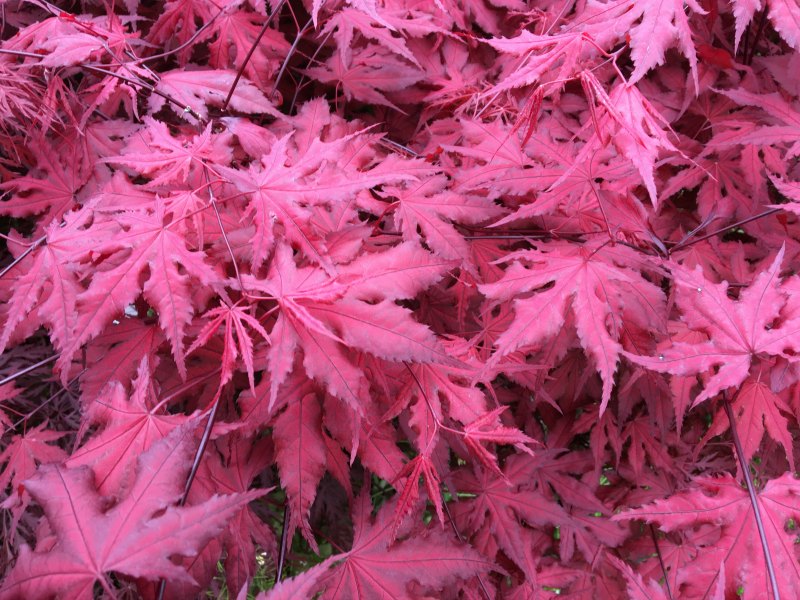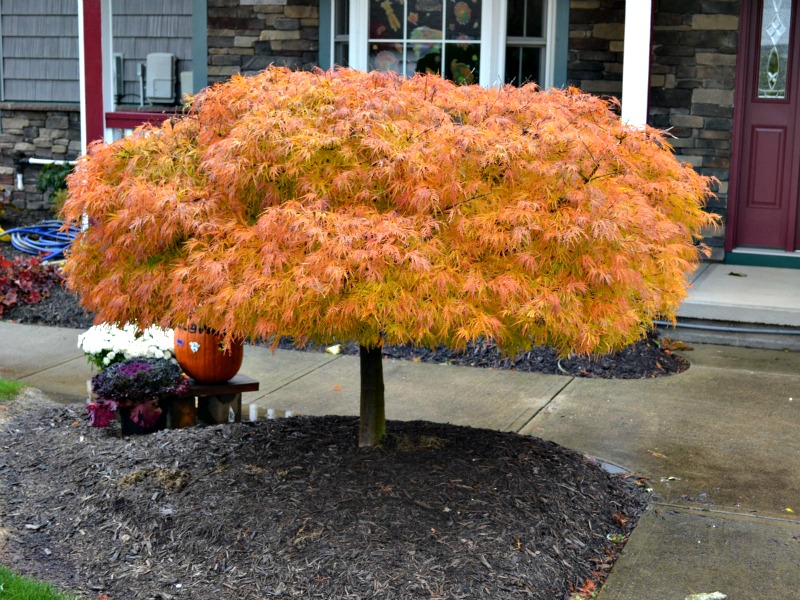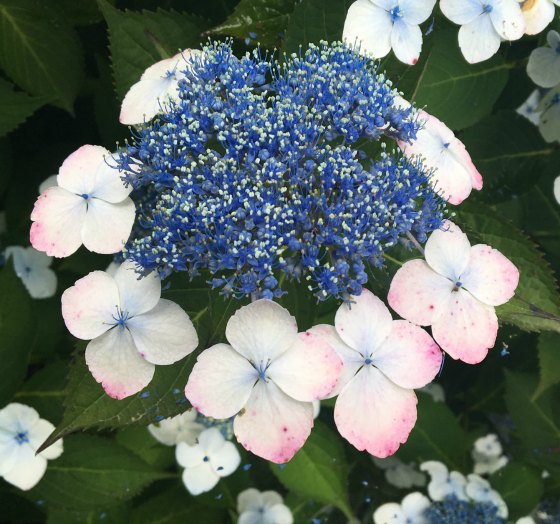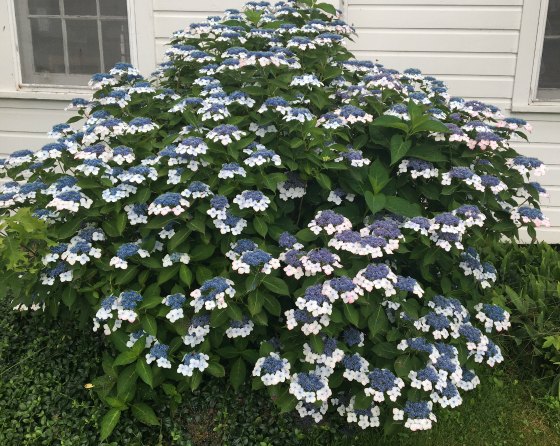Wow! That’s all I can say.
We have so many fun and exciting things happening in Our Members Area right now and we are accepting new members, but only for a short time.
Look at this Purple Ghost Japanese Maple. Would you like one? Two or Three?

Purple Ghost Japanese Maple
When I posted these photos a few weeks back people went crazy and wanted to know where to buy one. These things are really rare and really hard to find. Often selling for $200 or more. But right now we have a member that is offering all kinds of really rare, really unique Japanese maples in Our Buy/Sell Area with prices from $8.00 up to about $15.00. That’s it! Can you believe that?

Waterfall Japanese Maple
How about this beauty? Yesterday in his ad I saw some Virdis Japanese maples which are exactly like this ‘Waterfall’. Beautiful green leaves all summer, burnt orange in the fall. $15.00 is what he was asking. That’s it!
This member, he tells me that he will be posting more ads for weeks and weeks to come. Then come fall and winter lots and lots of other ads start appearing for Japanese Red Maples, usually around $2.00 to $3.00 each.
Would you like to Try Your Hand at Grafting Japanese Maples? Get this . . .
In Our Members Area not only can you buy Japanese maples that are perfect for grafting root stock, but you can also buy scion wood of unique and interesting varieties. A scion is really just a cutting taken from a rare Japanese maple, then you graft that scion onto a Japanese maple root stock. It’s fun, it’s exciting and it’s a great way to get beautiful Japanese maples and other plants for just a few dollars each.
Check this out . . .

Unknown Hydrangea

Unknown Hydrangea
Hanging out with the grand-kids we stumbled onto this beautiful hydrangea and I have no idea what it is. But I know that Our Members Will Know and more than likely one or more of them will have some for sale.
How much would you be willing to pay for this beautiful plant? Me? I know that once I get this identified I’ll be able to find them for around $2.00 each, maybe $2.50 each. Mike! What if it’s patented?
Here’s the deal with patented plants.
If this beautiful Hydrangea is not patented then I’ll buy 200 of them, pot them up and start taking cuttings from them. If it turns out that it is patented then I’ll buy 200 of them, pay the royalty, buy the required tags and I’ll just pot and sell them but not propagate them. In any case, I’m sure I can get these for less $2.50 each.
That’s The Beauty of Being a Member of our Backyard Growers Business Center. We do not pay retail price for plants. We always buy them wholesale and we have sources all over the country. Including many of our own members.
If You Join Right Now you can attend our Annual Backyard Growers Shindig. It’s coming up in a few weeks and it is a blast! A bunch of us get together to discuss plants, growing plants, propagating plants and selling plants! We have great food, great fun and life long friendships are made. I’m not kidding about that. We have created so many life long friendships among like minded people it’s amazing.
And get this! I have a couple more events planned for this year that I haven’t even told the members about. I’d like to take a bunch of members on a tour of two or more wholesale nursery operations. I have a lot of friends in this industry and I’m going to twist some arms and get them to pull back the covers and show us what they do, how they do it, and why. That’s coming up!
We are also planning an event that likely will be called “Liner Fest 2017”. This is an event where members can get together and stock up on beautiful liners. A rooted cutting is exactly as it sounds, a cutting, pretty much a stick, with some leaves and roots on the bottom. A liner is a rooted cutting that has been grown out for one growing season. It is starting to branch out and has a much heavier root system than a rooted cutting. Liners usually sell for $1.50 to $2.00 each.
This is a great way to pick up plants that you can sell immediately and in Our Members Discussion Area you will discover how our members sell hundreds of dollars worth of plants and thousands of dollars worth of plants.
These Prices for Plants are Real, take a Look!
These are just a few of the things that I spotted on the buy/sell board today.
Little Princess Spriea 60 cents each!
Pink Weigela 40 cents each!
Lucy Rose of Sharon 75 cents each
Corkscrew Willow 75 cents each
Dappled Willow 75 cents each
Eastern Redbud Trees $1.00 each
Tardiva Hydrangea $2.00 each
Silver Dollar Hydrangea $2.00 each
Phantom Hydrangea $2.00 each
Palibin Lilac $2.50 each
Miss Kim Lilac $2.75 each
Albert F. Holden Lilac $2.50 each
Congo Lilac $2.75 each
Madame Lemoine Lilac $2.75 each
Natchez Crepe Myrtle $3.00 each
Rheingold Arborvitae $1.50 each
Pow Wow Wild Berry Cone Flower $1.75 each
Cool Wave Purple Pansy 85 cents each
Merritt’s Supreme Hydrangea $2.90 each
You know what? If you love plants, it just doesn’t get more exciting that this. $7.00! That’s it Seven Bucks is all it costs to take the members area for a test drive. Join Right Now.
Questions, comments, mean things to say? Post them below.
Hi Mike I have been reading your emails for over a year now and my wife and I are finally going to take the leap and sign up for the Backyard Growers Business Center when you have time to open it again. I was wandering what plants you would recommend getting a start here in Purlear Hardiness Zone 7a? Thanks and Hope to see you on the inside soon
Daniel,
Can’t wait to see you on the inside! I think we’ll open this again in January, not sure at the moment unless Duston has already set a date. This list is what I share with new members.
21 Plants that are Easy to Grow and Sell Like Crazy
The following 21 plants are really easy to grow and they sell like hot cakes. They always have been really good sellers and they always will be really good sellers. And this list is just the tip of the iceberg when it comes to plants that you can grow and sell that people want to buy.
1. Forsythia
2. Red Weigela
3. Varigated Weigela
4. Pink Flowering Weigela
5. Red Twig Dogwood
6. Fragrant Viburnums
7. All Flowering Viburnums
8. Potentilla
9. Dappled Willow
10. Pussy Willow
11. Daylillies
12. Hosta
13. Huchera
14. All kinds of Perennials
15. Armeria
16. Boxwood
17. Japanese Hollies
18. English Hollies
19. Rhododendrons
20. PJM Dwarf Rhododendron
21. Hydrangeas
22. Rose of Sharon
23. Dwarf Alberta Spruce
24. White Dogwood trees
25. Chinese Dogwoods
26. Blue Rug Juniper
27. Gold Flame Spirea
28. Gold Mound Spirea
29. Ornamental Grasses of all kinds
30. Crimson Pygmy Barberry
31. Rosy Glow Barberry
Okay, that’s 31 and I could go on forever.
Here are some plants for warmer zones, 8,9, and 10
Fragrant Tea Olive
Gardenia,
Camellia,
Azalea,
Jasmines
Palm trees
Tropical Hibiscus
Burgundy Chinese Fringe Flower
Bogainvilla
Owari & Hamlin Oranges
Satsuma
Kumquat
Azalea (out the wazoo down here)
Crepe Myrtle (ditto)
Lilies
Camelias
amaryllis
hybrids such as Blossom Peacock and Papillo
Japanese Pieris
Satsuma’s
Star gazer lilies
Crape Myrtles of all kinds
Gardenia varieties-evergreen
Azalea varieties-evergreen & deciduous(native)
Camellia varieties-evergreen
Fragrant Tea Olive-evergreen
Nandina varieties-evergreen
Loropetalum/Chinese fringe flowers
Chase Tree
Abelia -so many new exciting varieties -good for zones 6-10!
Viburnums
Daphne
Cleyera-evergreen
Burning Bush/ Euonymus varieties…
Spirea -especially Bridalwreath, Little Princess, Goldmound…
Butterfly Bushes
Jasmines (vines-Carolina, Confederate)
Confederate Rose
Lady Banks Rose
Anise (check out Florida Sunshine)
Holly-Soft Touch/Sky Pencil/Youpon/Burfordii….
Crape Myrtles
Japanese Magnolias(Saucer, Betty, Royal Star…)
Southern Magnolias
Dogwoods
Red Buds
Japanese Maples
Evergreen hedge trees/shrubs
Leyland Cypress
Murray/Arborvitae
Japanese Cedar(cryptomeria)
false cypress(Chamaecyparis…)
Junipers-Blue Rug, Sargentii, Blue Point,…
Trees:
Chinense Pistache
Fruitless Mulberry
Weeping Willow
Live oak
Red oak
Catalpa
Vitex (or Chaste Tree)
Desert Willow
Shrub:
Nellie R Stevens
Wax Myrtle
Red Tip Photinia
Korean Boxwood
Radicans Gardenia
Loropetalum
Yaupon Holly
Perennials:
Salvias
Sedums
Butterfly Bush
Reeves Spiraea
Van Houtti Spiraea
Vines:
Honeysuckle (coral)
Crossvine
Star Jasmine
Mike is there something I can put on or do to my hydrangea bushes to make them bloom. I have had them (2) for 5 years and they look healthy and have tripled in size but 2 blooms one year on one and that has been it. Please advise if you will. Love Your newsletter. I live in the Foothills of the Blue Ridge Mountains in Morganton North Carolina.
Regards and thanks,
Don Peach Sr.
Don,
Best thing you can do is do nothing to them at all. Fertilizer will have them growing too much to slow down and make flower buds. But truth be told, you probably Nikko Blue which is notoriously a poor bloomer. I’d try a couple of other varieties.
How do I overwinter potted perrenials? I grew a bunch from seed but they’re not ready to sell yet since they’re not large enough to bloom. I live in eastern Pa , zone 6. Thanks!
Angie,
Like this; http://mikesbackyardnursery.com/2013/11/over-wintering-protecting-plants-for-the-winter/, or remove them from the pots and heel them in your garden.
How do U get kill brown or dollar spot in your grass???.
Let me know.. Thanks
Joe,
More than likely fusarium blight, a fungal disease associated with high temperatures and Kentucky blue grass. Don’t fertilize in the summer, over seed with a fine textured perennial rye grass.
Hi, Mike. Do you think a backyard nursery is a poor choice for someone going to school? Is it too time consuming if one actually wants a make at least somewhat of a profit? It’s not my intention to have this overwhelm my career or my studies, just as a possible avenue for extra income, which my folks are interested in continuing after my departure with their retirement in site.
Joshua,
The beauty of this . business is that you can do it any size you want, any pace you want and there are all kinds of different options of things that you can grow and sell. Rooted cuttings in a bed really don’t need a lot of attention and when it comes time to harvest them hundreds can be pulled, packed and shipped in a few hours. Or put into small pots then sold a few at a time on an by appointment basis. Or advertised in our members area or other places and offered for sale that way.
Mr. McGroarty, I have two short questions to ask:
1. I am successfully following the instructions in your video for starting root cuttings in the white dish pan with holes drilled through the bottom, covered by the white draw-string kitchen trash bag. Thank you for showing that simple method for us at-home garden enthusiasts. When in the process do I remove the white plastic bag covering? My cuttings have been rooting in the coarse sand covered by the white plastic bag for going on four weeks.
2. I am rooting Rose of Sharon and Clematis. We have rabbits and squirrels in our neighborhood. Do they eat baby Rose of Sharon and Clematis? I intend to plant the rooted baby plants right into my garden into the soil mixture you recommended.
Thanks for all you are teaching us.
Best regards, Jackie Bedwell, Boulder Colorado
Jackie,
After four weeks I’d remove the plastic bag and just keep the dishpan in the shade until things are well rooted. In the four weeks that those cuttings have been rooting, they have also harden off a lot and should now be fine without the bag. Wet them a couple of times a day. Rabbits? Rabbits love burning bush but I wouldn’t be concerned about rose of sharon or clematis. Be sure to do more things as hardwoods in the fall. http://mikesbackyardnursery.com/2015/01/easy-winter-time-plant-propagation-can-home/
Thank you, Mike. I do enjoy reading your posts and blog.
Jackie Bedwell
Hi,
I bought 2 Nikko Blue Hydrangeas at an Amish Auction about 4 years ago. They didn’t bloom again until this year…we are in NW Pennsylvania. Anyway, I looked on the net for advice and saw photos of Nikko Blues that looked like mopheads.. the ones I have look like Twist-N-Shout.
Any way to really tell what I have? I tried attaching a photo, but the copy-paste is not cooperating.
Dale,
No, there really is no way to know what you have. You’d be completely amazed at the number of different hydrangeas that are listed as patented. It’s endless. Not to mention the unpatented ones.
I love the idea of getting plants from an Amish Auction! Usually, we depend on them to build homes and furniture, especially stunning baby furniture. And hydrangeas of all sorts have been looking stellar here ~ just about the only plant the is tolerating our incessant rain. Bleh. I have to look into joining this membership deal because those prices for plants are ridiculously cheap and I have way too many blank and blah spots in my garden right now!
Laura,
Join up! We always have fun, http://backyardgrowers.com/join
Try using a tablespoon of banking soda every 2 weeks in your watering can and your hydrangea will reward you with an abundance of blooms. Try this next season…
I live in Southern California.
Does one need to cut back hops annually or can one simply let it grow?
Regards
William,
I have no idea but I do think we have hops article on this site written by somebody other than me. Just use the search feature on the right to find it.
Dear Mr. McGroarty,
Greetings from Philadelphia, PA.
I hope my post reaches your attention and finds you doing well.
We have four beautiful and healthy Japanese Maple trees; we inherited them already planted in the upper level of our back yard when we purchased our house 18 years ago.
Here, I have been wanting to transplant them to the lower part the our yard. But, everyone in my family are against me, fearing that I will kill the trees by doing so.
I’ve shown them your video, read to them your instruction, but I still can not ease their worries. Now, at this point I just want to go ahead without their support. I need another boost, a peace of mind to hear your advise about how simple it is to transplant Japanese Maple tree. Please, would you share with me your thought, if Transplanting Japanese Maple is FoolProof ? The tricky part is that they planted along the top of the brick retaining wall.
I wish I could include the pictures of the trees taken just today. They are are growing so big, and now they obstruct the view of the pool. And, I wish to move them to lower yard, the pool area. Also, clear way to extend our upper level patio.
I am looking forward to hearing back from you, and want to thank you in advance for any advice you will provide.
Sincerely,
Bonna ?
Bonna,
I won’t ever tell you that something is fool proof. Moving plants involves risk. But I will tell you this. Moving them now, during the growing season, is almost certain death. I would suggest that you consult with/hire a landscapers and at least get an opinion. But if you are to do it, wait until after Thanksgiving when the trees are completely dormant. See this; http://mikesbackyardnursery.com/2015/11/moving-a-large-laceleaf-weeping-japanese-maple-tree/
Bonna I lived for eight years in Hawaii where the growing season is all year long so there is never a good time to transplant.That being said was taught from this Hawaiian man how to minimize the dangers.of transplanting.First, dig your hole and fill it up with water then make mud soup by stirring it until it is a thick soup.Then put your plan in and fill it with good soil.Now for the best part of the trick.Because plants need water for Photosynthesis and when you transplant most times you disturb or damage the root system so it takes a week or so to be able to bring up water.You must shade the plant for at least a week so it can re-establish itself.I use broken branches with leaves and make a tent over the plant to keep most if not all the sunlight off the plant, but anything you can use that blocks out the sun will work.I have not lost a plant with this method so have a go at it and happy gardening.
Barry and others,
I don’t like moving non dormant plants, but if I had to, this process makes a great deal of sense.
Thank you everyone for taking the time to write back with your advice. I guess I should follow up with local professional. Very Best, Bonna
HI, Not sure if you received information on the “unknown hydrangea.” It looks like the: Let’s Dance® Starlight Bigleaf Hydrangea, Hydrangea macrophylla. I saw it also listed as: Lacecap Hydrangea. Not sure if these are different varieties or not.
Darlene,
I haven’t really looked into it yet but I’m sure it is one of the lacecap varieities. Now my job is to find one that looks like this that is not patented. I haven’t asked our members, http://backyardgrowers.com/join, yet.